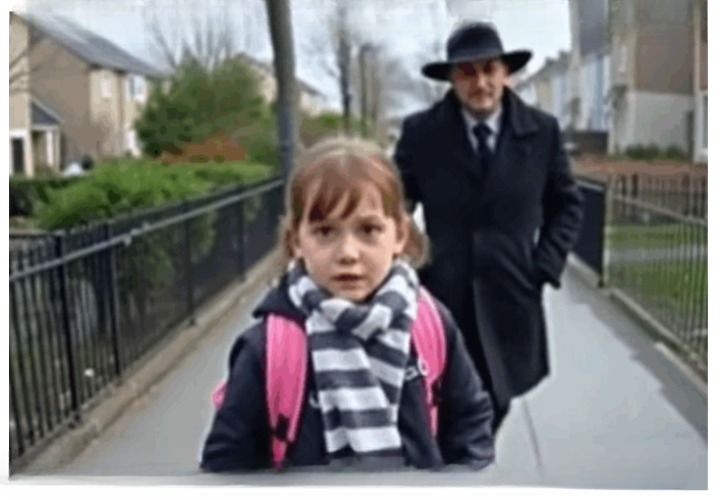It was a crisp autumn afternoon, golden sunlight spilling across streets blanketed in fallen leaves. Seven-year-old Emma should have been thinking about homework or what game she’d play later, but as she walked home from school, her small heart thumped uneasily—something felt wrong. Her backpack bounced lightly against her shoulders, and the last leaves of the season crunched under her sneakers. Out of the corner of her eye, she noticed a tall, dark figure walking steadily behind her. At first, the person seemed ordinary, just another passerby heading the same way. But as Emma turned the next corner, the stranger mirrored her movements. Her chest tightened, a chill crawling up her spine.
Her first instinct was to run—to bolt toward a house, to scream—but then she remembered her father’s words, etched in her memory like a shield: “If you ever feel unsafe, don’t hide. Don’t freeze. Make light. Make noise.”
Emma stopped mid-step and took a deep breath. Though small, she made a choice in that moment: courage. She spun around, raised her arms, and pointed dramatically at the sky. “Oh wow! Look at that!” she shouted, her voice cutting through the quiet street. She twirled once, then twice, her movements exaggerated, like a performance from her ballet class. Her scarf caught the sunlight, flickering like flames, while her shoes tapped rhythmically on the pavement, the sound echoing between houses.
To anyone watching, it might have seemed like a joyful child lost in play, but Emma’s laughter was purposeful—loud, confident, commanding attention. Every clap, every twirl, was a signal: she was not alone, not an easy target. The figure behind her faltered, slowing slightly, caught off guard by this unexpected display.
Inside a nearby house, Ms. Thompson, an elderly widow who often spent afternoons knitting by the window, noticed the scene. She saw a little girl spinning and a man standing a few paces behind, watching. Something didn’t feel right. Without hesitation, she grabbed her phone and stepped outside.
“Emma, sweetheart!” Ms. Thompson called, her voice firm yet warm, carrying across the street.
The stranger froze. Emma waved energetically. “Hi, Ms. Thompson!” she shouted back, confidence radiating in every movement.
The man muttered something under his breath, uncertain, and then abruptly turned the corner, disappearing as quickly as he had appeared. Emma’s performance had worked—she had transformed fear into a shield, using her presence and noise to protect herself.
By the time Ms. Thompson reached her, Emma’s legs were trembling. The adrenaline ebbed slowly, leaving both relief and lingering fear. “Are you alright, dear?” she asked, wrapping a protective arm around Emma’s small shoulders.
Emma nodded, her voice quiet but steady. “I remembered what Daddy said… make light and noise when things feel wrong.”
Ms. Thompson’s eyes softened with admiration and concern. She quickly called Emma’s parents and the police. Within minutes, patrol cars combed the neighborhood, but the man was gone. The officers, impressed by Emma’s quick thinking, commended her courage and presence of mind, praising how she had used awareness and creativity to turn a dangerous situation into safety.
That night, safe in her pajamas, clutching a steaming mug of cocoa, Emma recounted the event to her father. She described how she had danced, laughed, and spun, transforming fear into action. He listened, eyes glistening with pride and worry, and knelt to pull her into a tight embrace.
“You did exactly what you should have,” he said softly. “You were brave and smart.”
“I wasn’t that brave,” Emma admitted, small shoulders trembling. “I was scared.”
“That’s what bravery truly is,” he explained. “It’s doing the right thing even when your heart is pounding and your hands are shaking.”
Word of Emma’s courage spread quickly. Teachers shared her story in classrooms, reminding children that safety isn’t about strength or size—it’s about awareness, confidence, and the courage to act. The local police chief called her response “a textbook example of presence of mind and bravery.”
But Emma didn’t seek heroism. She only wanted other kids to know that fear doesn’t have to paralyze you. You can act, protect yourself, and transform danger into safety. In the following weeks, she worked with her father to create a school safety poster titled “Make Light, Make Noise.” It illustrated simple steps for children to stay visible, loud, and alert. The poster hung near the entrance, seen by every student daily.
When reporters later asked what had been going through her mind, Emma shrugged. “I didn’t want him to think I was scared. I wanted him to think I wasn’t alone.”
And she was right. Her light drew eyes, her noise signaled presence, and her courage turned fear into power. That day, a seven-year-old didn’t just evade danger—she rewrote it, creating a moment of defiance and teaching that even the smallest voices can wield immense strength.
Her father framed a photo of them together from that evening and placed it on the mantel. Beneath it, he left a handwritten note in her scrawl: “Make light. Make noise. Be brave.”
When anyone asked him what it meant, he simply said, “That’s not advice for kids. That’s advice for all of us.”
